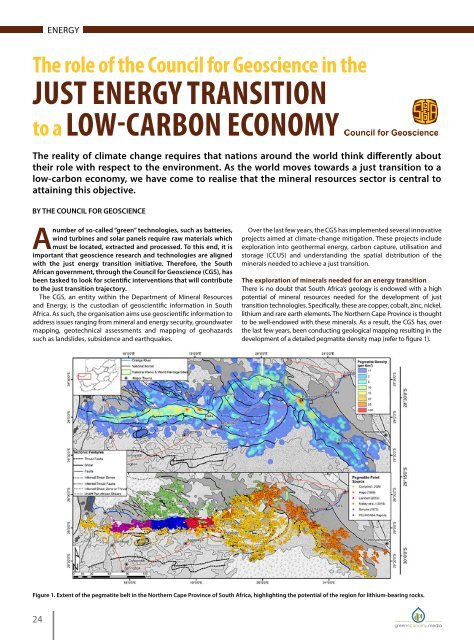Create successful ePaper yourself
Turn your PDF publications into a flip-book with our unique Google optimized e-Paper software.
ENERGY<br />
ENERGY<br />
The role of the Council for Geoscience in the<br />
JUST ENERGY TRANSITION<br />
to a LOW-CARBON ECONOMY<br />
The reality of climate change requires that nations around the world think differently about<br />
their role with respect to the environment. As the world moves towards a just transition to a<br />
low-carbon economy, we have come to realise that the mineral resources sector is central to<br />
attaining this objective.<br />
BY THE COUNCIL FOR GEOSCIENCE<br />
Pegmatite is a rock type known to host lithium, a mineral that is<br />
in high demand for the development of batteries needed for electric<br />
vehicles and energy storage from renewable sources such as wind<br />
and solar. The pegmatite density map provides, for the first time, a<br />
tool for mineral explorers to conduct detailed studies to quantify<br />
lithium potential and to assess extraction and utilisation possibilities.<br />
The role of carbon capture utilisation and storage<br />
Even though Africa’s contribution to global carbon emissions is the<br />
lowest worldwide, the continent is nevertheless one of the worst<br />
affected by global climate change. Moreover, carbon mitigation has<br />
become a priority worldwide. Several global commitments have been<br />
made by the South African government in this regard.<br />
To contribute to carbon abatement efforts, the CGS has been<br />
implementing a CCUS project, with the specific intent of capturing<br />
the carbon at a major emitting source and injecting it into a suitable<br />
geological storage site. The selected site is located in Mpumalanga<br />
province, near the town of Leandra, where there are a number of coalfired<br />
power stations. Indeed, the Sasol plant in Secunda is undisputedly<br />
the world’s largest point-source emitter of carbon dioxide. The rocks<br />
being targeted for injection are the porphyritic lavas of the Ventersdorp<br />
Supergroup (Figure 2). Through this project, the CGS hopes to capture and<br />
inject into the ground up to 50 000 tonnes of carbon dioxide which, over<br />
time, will reduce South Africa’s carbon footprint, thereby contributing to<br />
global climate change initiatives and facilitating the country’s transition<br />
to a low-carbon economy.<br />
A<br />
number of so-called “green” technologies, such as batteries,<br />
wind turbines and solar panels require raw materials which<br />
must be located, extracted and processed. To this end, it is<br />
important that geoscience research and technologies are aligned<br />
with the just energy transition initiative. Therefore, the South<br />
African government, through the Council for Geoscience (CGS), has<br />
been tasked to look for scientific interventions that will contribute<br />
to the just transition trajectory.<br />
The CGS, an entity within the Department of Mineral Resources<br />
and Energy, is the custodian of geoscientific information in South<br />
Africa. As such, the organisation aims use geoscientific information to<br />
address issues ranging from mineral and energy security, groundwater<br />
mapping, geotechnical assessments and mapping of geohazards<br />
such as landslides, subsidence and earthquakes.<br />
Over the last few years, the CGS has implemented several innovative<br />
projects aimed at climate-change mitigation. These projects include<br />
exploration into geothermal energy, carbon capture, utilisation and<br />
storage (CCUS) and understanding the spatial distribution of the<br />
minerals needed to achieve a just transition.<br />
The exploration of minerals needed for an energy transition<br />
There is no doubt that South Africa’s geology is endowed with a high<br />
potential of mineral resources needed for the development of just<br />
transition technologies. Specifically, these are copper, cobalt, zinc, nickel,<br />
lithium and rare earth elements. The Northern Cape Province is thought<br />
to be well-endowed with these minerals. As a result, the CGS has, over<br />
the last few years, been conducting geological mapping resulting in the<br />
development of a detailed pegmatite density map (refer to figure 1).<br />
Figure 2. Geological cross-section showing the rock units (in green) targeted for carbon storage. The depth of the selected injection site is around 1 200 metres.<br />
There is no doubt that South Africa’s geology is endowed with a high potential of<br />
mineral resources needed for the development of just transition technologies.<br />
Figure 1. Extent of the pegmatite belt in the Northern Cape Province of South Africa, highlighting the potential of the region for lithium-bearing rocks.<br />
Figure 3. Geothermal gradient showing the spatial distribution of relatively<br />
“hot” rocks targeted for exploitation.<br />
GEOTHERMAL ENERGY<br />
The International Energy Agency’s net-zero pathway recognises that,<br />
by 2050, renewables must provide two‐thirds of the world’s energy<br />
use, split between bioenergy, wind, solar, hydro-electricity and<br />
geothermal energy. Geothermal energy is a type of renewable energy<br />
sourced from hot source rocks deep underground.<br />
The current gaps of energy supply in South Africa, manifested by<br />
constant electricity cuts, can be closed by providing several energy<br />
sources, including geothermal energy. In South Africa, the CGS has<br />
been conducting multidisciplinary research that aims to locate<br />
suitable host rocks (Figure 3). To date, scientists have identified five<br />
areas that appear to be most prospective for the exploitation of<br />
geothermal energy.<br />
The research work started in Limpopo and KwaZulu-Natal<br />
provinces. Exploratory drilling at these sites is intended to clarify<br />
and quantify the depth of the hot rocks and, most importantly, to<br />
assess the economic feasibility of geothermal energy generation.<br />
This work is also meant to contribute to South Africa’s stated intent<br />
of introducing renewable sources into the country’s energy mix, as<br />
envisaged in the Integrated Resource Plan (IRP2019).<br />
24<br />
25

















